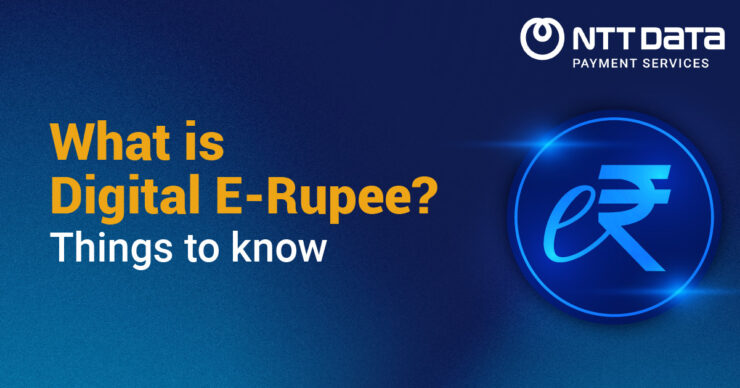
Table of Contents
Overview on Digital E-rupee
The Reserve Bank of India notified in December 2022 that it will pilot the use of India’s own digital currency, the digital e-rupee. Like other countries that have introduced or are exploring the idea of a CBDC, the digital e-rupee aims to make transactions more efficient, safe, and cheaper. It is backed by the Reserve Bank of India, making it legal tender.
What is a Digital E-rupee?
The digital e-rupee is the digital form of our existing paper Indian currency. While paper currency or coins will continue to exist, the digital e-rupee provides people with a new electronic currency option.
Just like the paper currency, the digital e-rupee is issued and regulated by the Reserve Bank of India. A digital e-rupee is essentially a digital token representing legal tender. It can be used to make payments and transactions electronically without needing physical currency.
How Does Digital E-rupee Work?
The functioning and transaction process of the digital e-rupee would be quite similar to existing digital payment modes.
- Users will need a digital e-rupee wallet to hold and transact with the digital currency. This wallet can be a mobile application or other digital interface.
- The wallets must be registered with valid KYC details for identity verification and compliance.
- Money can be transferred from a bank account to the digital wallet to load the e-rupee balance.
- Users can then make payments or send money to other users digitally using tools like QR codes, UPI or other modes.
- Transactions will be instantaneous and recorded on a distributed ledger for verification.
- Businesses can also receive e-rupee payments digitally for sales and services.
So, what is a digital e-rupee? It is a digital form of the rupee that works on similar principles to digital payments but is regulated by the RBI as a legal tender.
Key Features Of The Digital E-rupee
Some important characteristics and features of the digital e-rupee that distinguish it are:
- Issued and backed by monetary authority RBI, making it legal tender.
- Operates on blockchains for easy verification and security.
- Transactions are recorded digitally and are near-instant.
- Can complete peer-to-peer fund transfers without intermediaries.
- Provides the option to transact without physical cash.
- Offers additional benefits like loyalty/reward points.
- A digital e-rupee aims to make financial inclusion stronger.
- Helps move towards a less cash economy and digital transactions.
- Provides alternatives to private digital currencies and assets.
So, features like security, ease of use, and financial inclusion are the highlights of the digital e-rupee system.
Access The Best Online Payments With NTT DATA Payment Services India.
NTT DATA Payment Services India offers digital payment solutions and services to help businesses accept digital payments securely and reliably.
NTT DATA Payment Services India offers a complete payment solution to advance both your offline and online businesses. From online payment gateway and POS machines to IVR payments and Bharat QR Scan and Pay, we ensure maximum comfort, convenience, and safety for all your payments.
Conclusion
What is the digital e-rupee? In conclusion, it marks a revolutionary step in modernising India’s payment systems. It aims to drive efficiencies while retaining the key benefits of using legal tender. The pilot projects will help identify strengths as well as improvement areas.
With proper safeguards and a phased approach, it has the potential to emerge as one of the most popular payment options alongside UPI and cards in the future. It provides a safer and more convenient alternative to private digital currencies and assets.
Overall, the digital e-rupee is an idea whose time has come, and its impact on India’s digital economy will be worth watching closely.
FAQ
1. What is a digital E-rupee?
A digital e-rupee is the digital form of the Indian fiat currency rupee. It is issued and regulated by the Reserve Bank of India as a legal tender, allowing users to make electronic payments and transactions without physical cash.
2. How does a digital E-rupee work?
Users need a digital wallet to hold and transact with e-rupees. Money can be transferred from a bank account to the wallet. Users can then send/receive funds digitally using tools like UPI and QR codes. Transactions are recorded on a blockchain for verification.
3. Is digital E-rupee the same as cryptocurrencies?
No, the digital e-rupee is different from cryptocurrencies. It is a CBDC issued by the RBI, making it a legal tender backed by the central bank. Cryptocurrencies are decentralised digital assets that are not backed by any monetary authority.
4. Is digital E-rupee safe and secure?
Yes, digital e-rupee transactions are recorded on blockchains, which makes them verifiable and secure. Additional safety features like KYC verification also make the system safe for users.
5. How is the digital E-rupee different from UPI?
While UPI is an instant, real-time payment system, the digital e-rupee is the digital form of fiat currency issued and backed by the RBI. While UPI uses bank accounts, e-rupee requires dedicated digital wallets.


